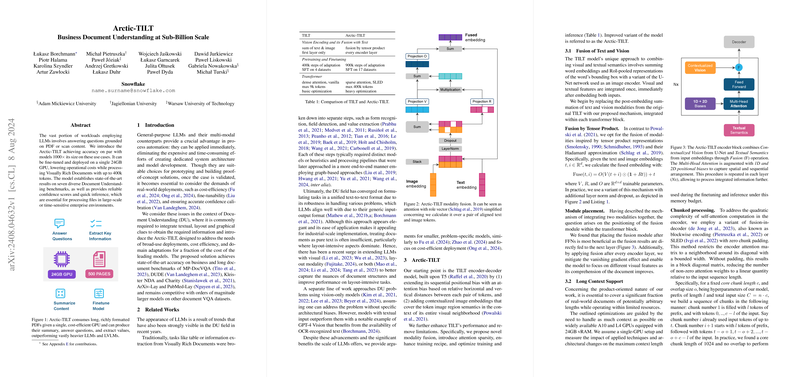An Essay on Arctic-TILT: Business Document Understanding at Sub-Billion Scale
Overview
The paper "Arctic-TILT: Business Document Understanding at Sub-Billion Scale" introduces a novel model aimed at effective and efficient processing of business documents using LLMs. Arctic-TILT achieves a notable balance of accuracy and cost-efficiency, leveraging both text and visual elements within documents to outperform significantly larger models in Document Understanding (DU) tasks.
This paper presents advancements in handling Visually Rich Documents with up to 400k tokens, achieving state-of-the-art results across multiple DU benchmarks, while operating cost-effectively on a single 24GB GPU. Notably, Arctic-TILT refines the existing TILT architecture, incorporating innovations in multimodal fusion, attention sparsity, and memory optimization to excel in real-world application contexts.
Technical Contributions
Model Architecture and Fusion Mechanism
The Arctic-TILT model enhances the original TILT architecture by introducing a novel text-vision fusion mechanism. Traditional TILT relies on summing visual and textual features post-embedding; Arctic-TILT improves this by integrating the modalities within each transformer block using a tensor product inspired mechanism. This advancement, termed Fusion by Tensor Product, enables more comprehensive multimodal interactions and consistently applies fusion across every encoder layer, as shown in Figure~\ref{fig:fusion3d.pdf}.
Handling Long Contexts
Arctic-TILT significantly extends the maximum input length that the model can handle, achieving up to 400k tokens without sacrificing performance. This capability results from several technical enhancements:
- Chunked Processing: Utilizing a blockwise encoding approach, Arctic-TILT efficiently handles large input sequences by processing them in manageable chunks. This strategy optimizes computational resources and memory usage.
- Nested Stack Checkpointing: This technique reduces memory required for activations by storing only the last layer's activations, enabling efficient processing of extensive document lengths during training.
- Random Chunks: This approach discards parts of the input during training to manage memory usage, ensuring the model is exposed to different document parts across training epochs.
- Memory-Efficient Attention: By optimizing the memory overhead of the attention mechanism, Arctic-TILT balances computational complexity and resource demands.
These optimizations collectively enable processing extensive input sequences on a single cost-efficient GPU, making Arctic-TILT suitable for deployment in large-scale, time-sensitive enterprise environments.
Performance Results
Arctic-TILT establishes state-of-the-art results on seven distinct DU benchmarks, including MP-DocVQA, DUDE, Kleister Charity, NDA, VQA-CD, ArXiv-Lay, and PubMed-Lay. It consistently outperforms or remains competitive with models many times its size, such as GPT-4 Vision and other LLMs, particularly excelling in tasks involving:
- Multi-Page Documents: Arctic-TILT shows strong performance on datasets like DUDE and MP-DocVQA, where documents can span up to hundreds of pages.
- Layout-Aware Summarization: The model outperforms previous state-of-the-art on summarization tasks involving structured documents like scientific papers in ArXiv-Lay and PubMed-Lay.
- Confidence Calibration: Arctic-TILT achieves exceptional calibration scores, with an Expected Calibration Error (ECE) of 7.6 and an Area Under the Risk-Coverage Curve (AURC) of 25.3 on the DUDE dataset, indicating reliable confidence scoring.
Practical Implications and Future Considerations
The Arctic-TILT model offers significant practical implications for businesses requiring efficient and effective processing of visually rich documents. Its ability to handle long document contexts makes it particularly valuable for enterprise applications, where documents can be complex and extensive.
Theoretical Implications
- Optimal Fusion Mechanisms: The introduction of the Fusion by Tensor Product mechanism suggests new approaches to integrating multimodal data within transformer architectures.
- Efficiency in Attention Mechanisms: Arctic-TILT's implementation of sparsity patterns and memory-efficient attention highlights paths for further research into reducing the computational overhead of attention mechanisms in large models.
Speculation on Future Developments
Future research could explore further fine-tuning and optimization of Arctic-TILT for specific domains, enhancing its adaptability to novel use cases. Additionally, extending its capabilities to handle more diverse visual elements and complex document layouts could push the boundaries of Document Understanding tasks. Integrating more advanced vision encoders, leveraging more sophisticated pretraining objectives, and exploring unified architectures for multimodal information processing could further bridge the gap between model efficiency and accuracy.
Conclusion
Arctic-TILT represents a significant step forward in the field of Document Understanding by demonstrating how well-optimized, smaller models can rival larger LLMs in both performance and efficiency. Its innovative approaches to multimodal fusion, long-context handling, and memory optimization provide a robust foundation for processing visually rich documents in cost-sensitive and real-time enterprise environments. This paper’s contributions underscore the potential for strategic design and optimization to drive advancements in AI while maintaining practical considerations for deployment and scalability.
